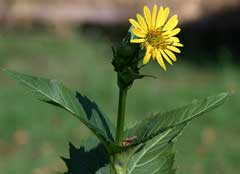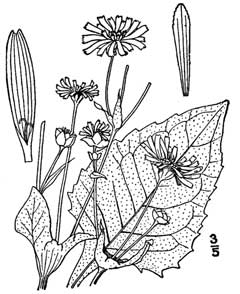 |
|
|
 |
| n illustrated flora of the northern United States, Canada and the British Possessions. Courtesy of Kentucky Native Plant Society. |
Translate this page:
Summary
Bloom Color: Yellow. Main Bloom Time: Late summer, Mid summer. Form: Upright or erect.
Physical Characteristics

 Silphium perfoliatum is a PERENNIAL growing to 2.5 m (8ft 2in) at a medium rate.
Silphium perfoliatum is a PERENNIAL growing to 2.5 m (8ft 2in) at a medium rate.
See above for USDA hardiness. It is hardy to UK zone 4. It is in flower in July, and the seeds ripen in August. The species is hermaphrodite (has both male and female organs) and is pollinated by Insects.
Suitable for: light (sandy), medium (loamy) and heavy (clay) soils. Suitable pH: mildly acid, neutral and basic (mildly alkaline) soils. It can grow in semi-shade (light woodland) or no shade. It prefers moist soil.
UK Hardiness Map
US Hardiness Map
Synonyms
Plant Habitats
Woodland Garden Sunny Edge; Dappled Shade; Shady Edge;
Edible Uses
References More on Edible Uses
Medicinal Uses
Plants For A Future can not take any responsibility for any adverse effects from the use of plants. Always seek advice from a professional before using a plant medicinally.
Alterative Antispasmodic Diaphoretic Emmenagogue Febrifuge Hepatic Pectoral Stimulant
Styptic Tonic Women's complaints
Cup plant was employed medicinally by several native North American Indian tribes who used it to treat a variety of complaints[257]. It is little, if at all, used in modern herbalism. A decoction of the root has been used to treat the stoppage of periods, and also to treat morning sickness and to prevent the premature birth of a child[257]. In view of these conflicting uses, it is best that it is not used by pregnant women unless under the guidance of a qualified practitioner[257]. The root is alterative, antispasmodic, diaphoretic, emmenagogue, febrifuge, hepatic, stimulant, styptic and tonic. It is used in the treatment of liver and spleen disorders and has also been used to treat morning sickness[4, 61, 257]. A decoction of the root has been used internally in the treatment of back and chest pain and lung haemorrhages[257]. A decoction of the root has been used as a face wash to treat paralysis[257]. A poultice of the moistened dried root has been applied to wounds to stop the bleeding[257].
References More on Medicinal Uses
The Bookshop: Edible Plant Books
Our Latest books on Perennial Plants For Food Forests and Permaculture Gardens in paperback or digital formats.

Edible Tropical Plants
Food Forest Plants for Hotter Conditions: 250+ Plants For Tropical Food Forests & Permaculture Gardens.
More

Edible Temperate Plants
Plants for Your Food Forest: 500 Plants for Temperate Food Forests & Permaculture Gardens.
More

More Books
PFAF have eight books available in paperback and digital formats. Browse the shop for more information.
Shop Now
Other Uses
References More on Other Uses
Cultivation details
Landscape Uses:Border, Massing, Specimen, Woodland garden. Succeeds in any ordinary garden soil[1]. Prefers a deep moisture retentive moderately fertile soil that is not too nitrogen rich, in sun or dappled shade[200]. Hardy to at least -25°c[187]. Plants have a deep and extensive root system which makes transplanting difficult. An aromatic resin exudes from the crushed leaves and stems[245]. Special Features:
Attracts birds, Attractive foliage, North American native, Naturalizing, Attracts butterflies. The plant is heat tolerant in zones 9 through 5. (Plant Hardiness Zones show how well plants withstand cold winter temperatures.
Plant Heat Zones show when plants would start suffering from the heat.
The Plant Heat Zone map is based on the number of "heat days" experienced in a given area where the temperature climbs to over 86 degrees F (30°C).
At this temperature, many plants begin to suffer physiological damage. Heat Zones range from 1 (no heat days) to 12 (210 or more heat days).
For example Heat Zone. 11-1 indicates that the plant is heat tolerant in zones 11 through 1.) For polyculture design as well as the above-ground architecture (form - tree, shrub etc. and size shown above) information on the habit and root pattern is also useful and given here if available. The plant growth habit is a runner spreading indefinitely by rhizomes or stolons [1-2]. The root pattern is rhizomatous with underground stems sending roots and shoots along their length [1-2].
References Carbon Farming Information and Carbon Sequestration Information
Temperature Converter
Type a value in the Celsius field to convert the value to Fahrenheit:
Fahrenheit:
The PFAF Bookshop
Plants For A Future have a number of books available in paperback and digital form. Book titles include Edible Plants, Edible Perennials, Edible Trees,Edible Shrubs, Woodland Gardening, and Temperate Food Forest Plants. Our new book is Food Forest Plants For Hotter Conditions (Tropical and Sub-Tropical).
Shop Now
Plant Propagation
Seed - best sown as soon as it is ripe in a greenhouse[200]. Prick out the seedlings into individual pots as soon as they are large enough to handle and plant them out in the summer. Division in spring[188]. This is very difficult due to the deep and extensive root system.
Other Names
If available other names are mentioned here
Native Range
NORTHERN AMERICA: Canada, Ontario, United States, Connecticut, Indiana, Massachusetts, Michigan, New Jersey, New York, Ohio, Pennsylvania, Vermont, West Virginia, Illinois, Iowa, Kansas, Minnesota, Missouri, Nebraska, North Dakota, Oklahoma, South Dakota, Wisconsin, Alabama, Arkansas, Kentucky, Louisiana, Mississippi, North Carolina, Tennessee, Virginia, Texas,
Weed Potential
Right plant wrong place. We are currently updating this section.
Please note that a plant may be invasive in one area but may not in your area so it's worth checking.
Conservation Status
IUCN Red List of Threatened Plants Status :

Growth: S = slow M = medium F = fast. Soil: L = light (sandy) M = medium H = heavy (clay). pH: A = acid N = neutral B = basic (alkaline). Shade: F = full shade S = semi-shade N = no shade. Moisture: D = dry M = Moist We = wet Wa = water.
Now available:
Food Forest Plants for Mediterranean Conditions
350+ Perennial Plants For Mediterranean and Drier Food Forests and Permaculture Gardens.
[Paperback and eBook]
This is the third in Plants For A Future's series of plant guides for food forests tailored to
specific climate zones. Following volumes on temperate and tropical ecosystems, this book focuses
on species suited to Mediterranean conditions—regions with hot, dry summers and cool, wet winters,
often facing the added challenge of climate change.
Read More
Expert comment
Author
L.
Botanical References
43200
Links / References
For a list of references used on this page please go here
Readers comment
| Add a comment |
|
If you have important information about this plant that may help other users please add a comment or link below. Only comments or links that are felt to be directly relevant to a plant will be included. If you think a comment/link or information contained on this page is inaccurate or misleading we would welcome your feedback at [email protected]. If you have questions about a plant please use the Forum on this website as we do not have the resources to answer questions ourselves.
* Please note: the comments by website users are not necessarily those held by PFAF and may give misleading or inaccurate information.
To leave a comment please Register or login here All comments need to be approved so will not appear immediately.
|
Subject : Silphium perfoliatum
|
|
|
|